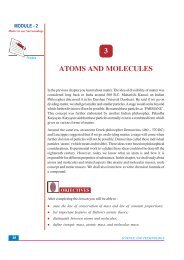NIOS : The Way Forward - The National Institute of Open Schooling
NIOS : The Way Forward - The National Institute of Open Schooling
NIOS : The Way Forward - The National Institute of Open Schooling
Create successful ePaper yourself
Turn your PDF publications into a flip-book with our unique Google optimized e-Paper software.
8 / <strong>NIOS</strong>: <strong>The</strong> <strong>Way</strong> <strong>Forward</strong><br />
stage <strong>of</strong> education are roughly <strong>of</strong> the same age group and belong to the<br />
same geographical and in good measure also belong to comparable sociocultural<br />
contexts. <strong>The</strong>refore, from the viewpoint <strong>of</strong> physical, social, emotional<br />
and mental development, they more or less constitute a homogeneous group.<br />
This makes it easy for the school or college to organize common and culturespecific<br />
experiences for the students. But the situation in the case <strong>of</strong> open<br />
learning is much more challenging as the learners come from diverse<br />
backgrounds and there is a sharp difference in the age range. In the open<br />
learning system, most <strong>of</strong> the learners are young adults, likely to be in their<br />
20’s or 30’s or even older. In fact, since there is no upper age barrier, even a<br />
senior citizen can enroll. In the formal system, the students generally do not<br />
have any experience <strong>of</strong> the world <strong>of</strong> work but in the open learning system, a<br />
large number <strong>of</strong> students may be working persons or have had work experience<br />
and choose the <strong>Open</strong> Learning channel to continue their education or to update<br />
their skill. As a result, we are dealing with mature adults and with greater<br />
capacity for independent learning. It is unfair to compare the two.<br />
Because <strong>of</strong> the major differences in the leaner pr<strong>of</strong>ile, the ODLS introduces<br />
many changes to accommodate to the needs <strong>of</strong> its learners. Accordingly, the<br />
<strong>Open</strong> Learning system students have the freedom and flexibility to pursue<br />
courses <strong>of</strong> their choice at their own pace and as per their convenience and<br />
may take a much longer time to complete a particular course. <strong>The</strong> ODL students<br />
have more autonomy and freedom to study at a place and time <strong>of</strong> their choice.<br />
Still another difference in the two systems is in the mode <strong>of</strong> curriculum delivery.<br />
In the formal system, there is a set pattern <strong>of</strong> curriculum transaction, that is<br />
sequential teaching <strong>of</strong> different syllabus units by the teachers and following<br />
the prescribed textbooks. However, the learners <strong>of</strong> the ODL system can learn<br />
on their own with the help <strong>of</strong> specially prepared Self-Instructional Material<br />
(SIM) at a time and place <strong>of</strong> their choice and convenience. Through the Personal<br />
Contact Programme, they do get an opportunity to seek guidance periodically<br />
from the tutors at the study centers.<br />
<strong>The</strong> several differences between the two systems mentioned above, highlight<br />
the need for a curriculum for the ODL system, which is different from the<br />
curriculum <strong>of</strong> the formal system in several ways.<br />
Some <strong>of</strong> the distinguishing characteristics <strong>of</strong> the open learning curriculum are<br />
mentioned below.<br />
1.3.9 Paradigm Shifts in the ODLS<br />
●<br />
●<br />
●<br />
●<br />
Shift <strong>of</strong> learning from only the classroom to anywhere<br />
From teacher-centric to learner-centric<br />
From teacher as instructor to teacher as a facilitator <strong>of</strong> learning<br />
From mainly oral instruction to also technology-aided instruction

















